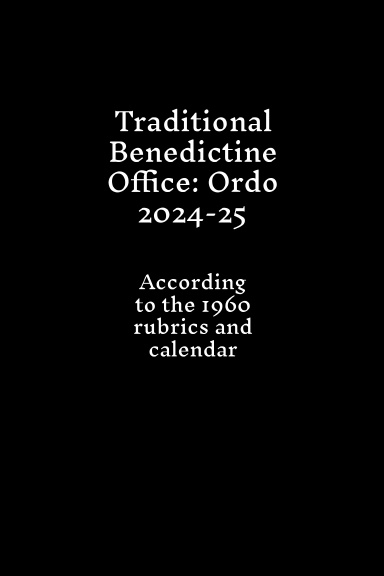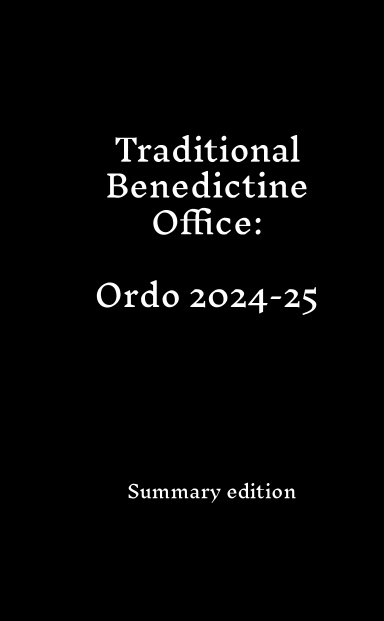Apologies for my slowness in continuing this series on the responsories, but my hopes my health was improving proved unfounded!
Nevertheless, here is the next post in the series, though I should flag that it is mostly by way of context for the debate, and somewhat controversial in content.
In order to re-examine what the de psalmiis responsories represent, we need I think, to also reassess some of the standard assumptions about the early Roman Office, and about the responsories themselves.
And the question I want to examine first is, can we really be sure that the psalm based responsories represent the oldest layer of them?
A starting point for this question goes to the monastic nature of Matins (aka Vigils or Nocturns).
Monks and the Office
One of the earliest descriptions we have of Matins we have comes from the fourth century pilgrim Egeria’s visit to Jerusalem, where she observed the weekly Sunday vigil where the bishop, clergy and people appeared for the public offices of Vespers and Lauds, but left the monks and nuns to kept Vigil through the night.
This seems to have been the common pattern: monks prayed through the night so that the clergy and laity could sleep, protected from the attacks of the demons of the night by their prayers.(1)
That is not to say that the people didn't attend Matins at least some of the time.
We know from St Jerome that Vigils (that presumably included the Office in some form) for the feasts of saints, held at the site of their relics, were popular with the people.
Similarly, the early stational liturgies for major feasts such as Christmas, Easter, and Lent almost certainly included Vigils with psalms). But we have little if any information on the content of these liturgies until the seventh century.
It is likely, too, that some form of prayer in the night may have been said privately at home by the clergy and devout laity, but we have no evidence that there was any obligation to do so, and no information at all about the content of any such prayers.
Instead, virtually all of the information we have about early forms of Matins relates to monastic versions of it, such as Cassian's description of the twelve psalm Sunday Matins said by the hermits of Northern Egypt in the early fifth century; the 12 to 18 psalm Night Office used by the monastery associated with St Augustine from around the same time; and the very much longer Vigils employed in Gaul, Burgundy and Provence in the early sixth century.
Clerical obligation to celebrate the Night Office
Around St Benedict's time though, in the early sixth century, a new trend started, broadening the obligation to attend Vigils.
For the clergy, records have survived of two monk-bishops, Ss Fulgentius (North Africa) and Caesarius (Provence) requiring their clergy to attend (monastic) Matins.
And in the Eastern Empire, Justinian passed legislation in 528 mandating that priests say the 'nocturnal, morning and vespers prayers'.
The same trend also seems to have penetrated Rome, as the mid-sixth century Liber Diurnis includes a promise formula for bishops, the Cautio Episcopi, requiring them and their clergy to celebrate Matins in Church. Indeed, there is a typically oblique reference that may be to this new obligation in the Liber Pontificalis: Pope Hormisdas (514 - 523) is said to have 'taught the clergy the psalms'.
Just how successful these attempts to impose the Night Office on priests was is another matter: there is evidence from the sixth century of priests refusing to do it.
Moreover the Liber Pontificalis for the seventh and eighth centuries repeatedly makes it clear that the Office, and most especially Vigils, continued to be regarded as the domain of monks, not clerics. There are several entries detailing agreements that monks would say the Office in various basilicas. There are numerous records of monasteries attached to the basilicas and tituli churches of Rome being established or restored for exactly this purpose. There is a complaint from the people that 'the monks' were singing twelve psalms at Matins rather than the customary three during the Easter and Pentecost octaves. When new feasts or chapels were established, vigils for their feasts were specifically entrusted to monks, while priests were to say Mass for the relevant feast.
And when, in the eighth century, Pope Stephen II (752 - 757) attempted to stamp out the practice of anticipating Matins the afternoon or evening before, part of his solution to the problem was to add an extra monastery to St Peter's in order to have a sufficient number of monks to manage the task.
It is not until the Carolingian regulations in the ninth century (and probably not by coincidence, the invention of notation for chant, so that performance of it did not rely entirely on memory), that evidence for a broader practice can be found.
A secular Office?
All the same, if we assume an attempt was made to impose the Night Office on clerics, and at least some did it, did they simply say the monastic Office of Rome (assuming there was such as thing), or some newly devised secular form?
Learning and chanting the monastic Night Office, though, would surely have been a mammoth task, especially if, as the liturgists claim, the day hours were largely fixed already by this time).
One possibility is that the clergy were only required to say a fairly abbreviated version of the hour, and the description of what was required in the Cautio Episcopi can be read as consistent with this (but see the appendix below), but that then begs the question of how the Roman secular Office as we know it, with its eighteen psalm Sunday Vigil and twelve psalms a day norm, emerged (presumably the reason the liturgists have generally ignored it).
Either way, it is reasonable to assume, I think, that abbreviated or otherwise, clerics drew on the existing Office chant repertoire rather than inventing their own.
Implications for the responsories
And this is important because when the liturgists first focused on this de psalmiis set of responsories, their assumption was that the psalms would represent the oldest chronological layer of the Office.
It is a plausible enough assumption on the face of it: in the Mass, psalm based propers (introits, communios etc) certainly do appear to be the oldest layer of the liturgy.
The Office chants, though, most particularly for the Night Office, almost certainly developed primarily in a monastic environment, while Mass chants developed in a clerical one, and that means that although they share some characteristics, they also have some differences.
In particular, monks seem to have been rather more adventurous in the texts they drew on: where Roman clerics, probably in the early sixth century, drew up lists of non-Scriptural materials that was absolutely not to be read in Church; St Benedict, by contrast, included Patristic commentaries in the readings for Matins.
And where the Roman (and some other regions) church resisted the use of hymns, monks employed them in the Office (indeed the current Vespers hymns have long been attributed to the great monasticizing pope, St Gregory I).
Unsurprisingly, then, musicological analysis, has found that when it comes to the Office, neither text alone or analysis of the music alone is sufficient to decide the relative age of a responsory. (2)
In particular, whether the text is psalm-based, other Scriptural or non-Scriptural cannot be used to allocate responsories to particular chronological layers of the Office.
And when it comes to the chants themselves, the de psalmiis responsories are musically indistinguishable from the other early sets of responsories, such as those for the Book of Kings.
But first, enjoy the recording of Afflicti Pro Peccatis (above), one of the non-Scriptural responsories sung between Epiphany and Septuagesima, since Trent preserved only in the monastic Office.
Notes
(2) See in particular Katherine Eve Helson, The Great Responsories of the Divine Office: aspects of structure and transmission. PhD, Universität Regensburg, 2008 and Brad Maiani, Readings and Responsories: The Eighth-Century Night Office Lectionary and the Responsoria Prolixa, The Journal of Musicology, Vol. 16, No. 2 (Spring, 1998), pp. 254-282.
Appendix: The Cautio Episcopi Office
The version of Matins described in the Liber Diurnis has generally been either ignored by the liturgists, or explained away as a purely hypothetical text.
That is possible, but, as others have pointed out, unlikely given that the introduction of a requirement for the clergy to attend Matins around this time can be found in other sources as well, not least in references to priests resisting it!
Another possibility worth considering though, is that the text itself has been misinterpreted.
The text essentially prescribes that during summer, matins has 'three readings, three antiphons and three responsories' on weekdays, in winter four of each, and on Sundays 'nine readings with antiphons and responsories'.
It is generally assumed that antiphon here means psalms sung antiphonally, while responsories either means responsorial psalms or (more likely) the Great Responsories.
But there is another option, since the term 'antiphon' in other early forms of the Office could also mean a group of, usually three (but sometimes more or less), psalms.
It is noteworthy in this regard that the earliest descriptions of the Roman Office describe perhaps a remnant of this, with sets of psalms as being said under one doxology - three groups of four psalms at Sunday Nocturns, for example, and the Laudate psalms at Lauds (which probably originally had individual doxologies in the Benedictine Office, in order to preserve the symmetry of the 'sacred number seven' psalms said in the morning and evening).
If interpreted this way, the Cautio Office prescribed looks rather more like the Roman Office as we know it, with either 9 or 12 psalms on weekdays depending on the season, and 18 on Sundays.






